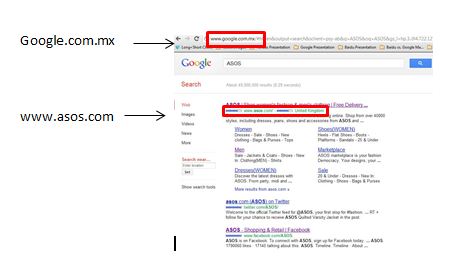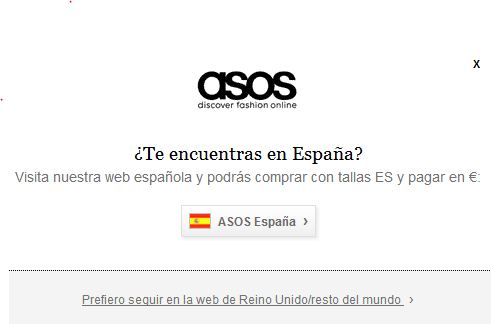Take one look at ASOS’ global financial performance in the first quarter of 2012 and you’ll be amazed by its strong international growth in a generally tough economic climate. The UK-based online fashion success story saw its total sales rise by 31%, which was largely driven by a strong international performance.
For the quarter, global sales made up 65% of ASOS’ £136.9m total revenues, while UK sales accounted for the remaining 35%. But what’s perhaps more telling of the company’s phenomenal international growth is the fact that UK sales exceeded those made beyond its domestic borders up until the beginning of 2011. Even more so as this revenue turnaround hasn’t come at the expense of decreasing or even stagnating sales in the UK; rather, international growth has simply outpaced that of ASOS’ home market.
When breaking down international sales, “the fastest growth came in the US market, where sales lifted by 83% to £12.9m, while EU sales were up by 27% to £32.3m, and sales in the rest of the world grew by 61% to £43.5m. Total group revenues, which also include delivery receipts and third-party revenues, rose by 31% to £141.1m”, notes Internet Retailing.
Online fashion is big business. And ASOS is a big fish in that pond. But while the company’s financial figures suggest they’re doing exceptionally well on a global scale, could they be performing even better?
Let’s review the following four areas of importance (there are of course many more factors which need to be taken into consideration for an exhaustive review, but for the sake of the length of this piece I’ve restricted myself to the four factors below):
- Domain Structure
- Geo-Selector (Language Direction)
- Currency
- Social Media
Domain Structure
Domain structure is a critical consideration when internationalising a website. There’s no magic recipe or universally applicable best practice when it comes to deciding on the structure of your site, as it will vary from one organisation to the other. Although ccTLDs (e.g. www.yoursite.de) provide the strongest geographic signal in search engine algorithms and are generally the ideal solution, they can easily prove too costly and time-consuming to maintain for smaller organisations. However, for already well-established sites and brands, which are experiencing a significant revenue contribution from international markets, like ASOS, going with this option is desirable.
ASOS has six international sites (using ccTLDs) of its website targeted at the U.S., France, Germany, Italy, Spain and Australia – its currently largest business markets. While it’s natural to focus on optimising your core markets, for a company like ASOS, which claims to serve 4.7 million active customers from 160 countries, is that really good enough?
ASOS sitemap
Sure, by offering English, French, German and Spanish language versions, ASOS covers a large share of internet users worldwide. But what about the 538 million Chinese netizens or the exponentially growing number of Russian-speaking online shoppers?
Moreover, is it ideal to direct all the traffic you receive from, say, Mexicans searching on google.com.mx to the Spanish version targeted at Spain? Or worse even, the UK version?
If questioning why a local version isn’t provided, a common management response would likely go something like this: “It simply doesn’t drive sufficient business to justify the extra amount of effort and time we’d have to put into it”.
This in itself is an inadequate, not well-stated case. I might be mistaken, of course, and instead be provided with an informed response like: “Our market-specific research shows that the amount of money and time we’d be investing in maintaining a local version targeted at Mexico exceeds the estimated relative benefits of improved rankings, increase in visitors and higher click-through- and conversion rates, when comparing it to our current performance on those metrics”. Whichever is the case for ASOS, I’m not qualified to say. But the former is generally prevailing. And until SEM gets that large seat at the table it really deserves, it’ll probably remain so.
Geo-Selector
For international websites that serve up multiple country and language versions, having a good geo-selector in place is crucial for usability and SEO.
You’d obviously want the appropriate version to display at its intended audience. From a usability perspective, this means making it as easy as possible for visitors to switch to their preferred country and language version. From the SEO side of things, you’d want to ensure that spiders are able to crawl and understand the structure of your site.
Like with domain structure, there’s no one-size-fits-all solution here. There are different types and approaches, some of which are explained more in-depth in this article.
ASOS is utilising an IP geolocation lookup which redirects the visitor according to his location – that is if browsing from one of the six countries for which ASOS has local sites. It doesn’t automatically redirect the visitor, which indeed is positive, as IP redirection should always offer choice.
When browsing from Spain, this automatically pops up when entering ASOS’ main page in English
Currency
While ASOS only provides locale site versions for six select countries, it offers a relatively wide selection of currencies – 15 to be exact. And unlike its international sites, price listings in Chinese Yuan and Russian Rubles are available.
Again, ASOS utilises an IP lookup to automatically display the given currency of the country where the user is surfing from. If surfing from Denmark, for example, you’ll get directed to ASOS’ main page in English, but prices will be listed in Danish Kroners. That’s a neat feature which helps build instant trust, however, it’s a weak substitution compared to a fully localised site.
When that’s said, displaying prices in Kroners but providing the site itself in English might convert almost as well as a fully localised site in Scandinavia, due to a generally high degree of English proficiency throughout that region. In China or Russia, however, where English proficiency is much lower, it might provide little value to display prices in local currency if that currency symbol is about the only thing the visitor is able to understand on the site.
But what about Google Translate? I think we can all agree that while in many cases it can be a useful feature, it doesn’t exactly ooze professionalism, nor does it help gain consumer trust.
Social Media
For international organisations, the ever-growing importance of social raises the question of whether to localise social media efforts or to stick with a “single-language” approach.
Thus far, ASOS is employing the latter, meaning that all of its social media profiles – Facebook, Twitter, YouTube, Google+, and a wide range of fashion blogs (I might have missed out on some) – are in English. No trace of German, Spanish or French here.
Could engagement be improved by segmenting the audiences by world languages – as an absolute minimum – and communicating with those segments separately in their native language, I’ll ask rhetorically? If doing so, wouldn’t that already rather significant chunk of business coming from non-English speaking nations be likely to further soar?
From an SEO perspective, it also makes sense for ASOS to expand its social reach in order to consolidate its local domains for France, Germany and Spain. Obviously, the targeted keywords for ASOS’ non-English sites are different. By linguistically diversifying the social media presence, ASOS would be able to further build authority by crafting content around those country-specific targeted keywords, as well as benefit from much more targeted internal link building tactics.
Well Worth The Effort
If you turn on the TV here in Spain, for instance, you’ll quickly notice that everything foreign is dubbed into Spanish. France and Germany are not much different in this regard. Consequently, marketers targeting those countries are dealing with consumers who are accustomed to being provided with whatever information they seek in their native language.
If ASOS is planning on boosting its prominence in large markets like Russia or China in the near future, this behaviour will only be even more prevalent – and the following need for localisation similarly so.
Obviously, the extent to which localisation is financially feasible will depend on the resourcefulness and business scope of the organisation in question. But for a company whose total quarterly revenues are well in excess of £130m ($160m) – of which a large share is contributed by non-English speaking markets – putting in those extra resources to further build on its international momentum would be well worth the effort, I’d say.












